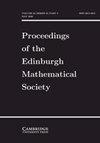拓扑四元组的共生和倾斜积
IF 0.9
3区 数学
Q2 MATHEMATICS
Proceedings of the Edinburgh Mathematical Society
Pub Date : 2024-05-22
DOI:10.1017/s0013091524000208
引用次数: 0
摘要
给定局部紧密群在拓扑簇上的循环,作者构建了一个斜积拓扑簇,并确定了拓扑簇可以被识别为斜积的条件。我们研究了斜积的 ${C^*}$ - 代数与原簇的 ${C^*}$ - 代数上的某个本征协效之间的关系,发现协效的交叉积与斜积同构。作为应用,我们证明了对偶作用的还原交叉积与原始簇的 ${C^*}$ - 代数是莫里塔等价的。本文章由计算机程序翻译,如有差异,请以英文原文为准。
Coactions and skew products for topological quivers
Given a cocycle on a topological quiver by a locally compact group, the author constructs a skew product topological quiver and determines conditions under which a topological quiver can be identified as a skew product. We investigate the relationship between the ${C^*}$ -algebra of the skew product and a certain native coaction on the ${C^*}$ -algebra of the original quiver, finding that the crossed product by the coaction is isomorphic to the skew product. As an application, we show that the reduced crossed product by the dual action is Morita equivalent to the ${C^*}$ -algebra of the original quiver.
求助全文
通过发布文献求助,成功后即可免费获取论文全文。
去求助
来源期刊
CiteScore
1.10
自引率
0.00%
发文量
49
审稿时长
6 months
期刊介绍:
The Edinburgh Mathematical Society was founded in 1883 and over the years, has evolved into the principal society for the promotion of mathematics research in Scotland. The Society has published its Proceedings since 1884. This journal contains research papers on topics in a broad range of pure and applied mathematics, together with a number of topical book reviews.

 求助内容:
求助内容: 应助结果提醒方式:
应助结果提醒方式:


